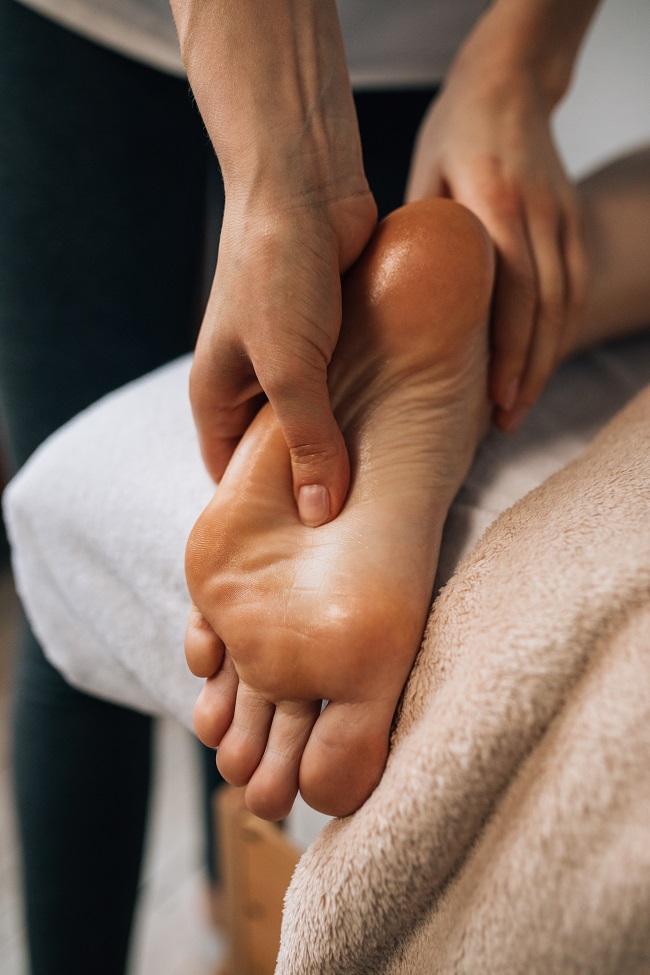While some aches and pains in the feet might have a fairly obvious cause (a twisted ankle, a badly stubbed toe, a blister from a stiff new pair of shoes), arch pain can feel somewhat mysterious.
Even on a day when you’ve barely walked from the kitchen to the couch, if you’re asking yourself, why do the arches of my feet hurt? There might be an underlying cause.
Keep reading to get to the bottom of your arch pain.
What Causes Arch Pain?
Because the arch of your foot affects everything that the feet do, from walking and jumping to running and dancing, pain in the arch can feel especially bothersome. It can be even more than just a nuisance—a chronically painful arch can slow you down and limit your mobility.
Discomfort in the arches of your feet can be caused by any number of things, but inflammation or injury are the most common root causes. Let’s take a closer look at each one:
- Inflammation is a broad term for the body’s reaction to stress or pain. Sometimes if the body is under stress, it can attack its own tissues, causing redness, swelling, stiffness, and pain.
- Injury is temporary pain caused by accidentally hurting the arch in some way. Think rolling an ankle or painfully stubbing a toe. If left untreated, injuries might cause further inflammation and stress as the body heals.
Some other possible factors behind foot arch pain are:
- Overuse and excessive exertion
- Weight gain
- Pregnancy
- Stress
- Neurological problems
- Structural issues with the bones or connective tissue of the feet
To narrow down what could be causing your arch pain, use a simple pain scale between 1 and 10. How intense is the foot pain from 1 to 10 when you sit, stand, walk, and jump? Additionally, note if the pain happens after certain activities (like working a long shift at work, or bending down to get something from a low cabinet).
This type of information can help you narrow down the type of arch pain you might be experiencing. There are a few conditions that can cause pain in the foot arch. Let’s dive into some of the most common types of arch complaints and how to soothe them.
#1 Plantar Fasciitis
One of the most common foot problems that may be causing your arch pain is plantar fasciitis. The plantar fascia is a long band of connective tissue that runs along the bottom of your foot and makes up much of the structure of the arch. When the plantar fascia is functioning as it should, it’s what allows the foot to flex, bend, and move. Think of it like the support beam that holds up the rest of the foot.
Since the plantar fascia plays a major role in foot stability and structure, this means that you can face serious discomfort when this connective tissue isn’t able to do its job properly. Its prime location also makes it susceptible to injury, particularly for those with high-impact exercise routines like runners. In fact, it’s so common that it’s got a name of its own: plantar fasciitis.
Plantar fasciitis is caused by overexertion or inflammation in the plantar fascia. One thing that might tip you off as to whether you’re suffering from plantar fasciitis is if the pain feels much worse when you first wake up. When the muscles in the feet contract as you sleep, they tighten up, causing early morning pain. The pain typically gets worse with activity or excessive standing.
How Can I Fix It?
Plantar fasciitis is usually caused by wearing unsupportive footwear. An easy and quick fix is trying out an orthotic insert like the Vionic Active Insole, specially designed to absorb shock and boost motion control.
You can also take it one step further by swapping out uncomfortable old shoes for a more supportive pair. Since plantar fasciitis is commonly seen in those who are active, taking a look at your sneakers is a great place to start. Try a pair of ultralight, podiatrist-designed Captivate Sneakers for your next morning walk or gym workout to keep your arches supported and pain-free.
One important thing to keep in mind with plantar fasciitis is that pushing yourself and overexertion can worsen your pain. Make sure you’re taking time for rest and recovery, and consider some preventative steps like icing your feet or finding a gentler workout routine.
#2 Posterior Tibial Tendon Dysfunction
Did you know you can develop flat feet as an adult? While many of those with flat feet have them all their life, flat feet can actually occur in adulthood as the result of a condition called posterior tibial tendon dysfunction. This flat foot condition is also the sneaky culprit behind many cases of arch pain.
The posterior tibial tendon runs from the midpoint of the arch of your foot up through your calf muscle. Tying the muscles of the foot and the lower leg to the bones, this tendon helps keep the arch and the entire foot supported as you’re walking and serves as the major connection between the lower leg and the foot.
When this tendon becomes inflamed or irritated, it can no longer do its job of supporting the arch of the foot, causing it to collapse and giving the foot a flat appearance. When this happens, it’s called a fallen arch
and can cause all of the usual problems that come with flat feet, including:
- Swelling
- Pain in the arch of the foot, the inner ankle, and the back of the calf
- The foot turning outwards
- Loss of stability and balance in the foot
How Can I Fix It?
The most important thing you can do if you’re dealing with posterior tibial tendon dysfunction is rest and incorporate gentle stretches like heel or calf raises. These exercises help strengthen the foot without putting any additional pressure on it.
Another option to consider is a sturdy, lightweight insole like the Vionic Unisex Relief 3QTR Insole, which is designed to provide robust support to your rear foot and keep you feeling comfortable and pain-free while you’re on the go. The insole is also made to prevent overpronation or rolling your feet inwards as you walk, which can often cause feet to flatten.
#3 Stress Fractures
If stress fractures sound stressful, you’re not alone in thinking so. While most fractures or bone breaks start with a dramatic spill or tumble, these fractures are actually the result of consistent overuse without allowing time for the body to properly heal and recover.
Stress fractures are different from and more serious than conditions like plantar fasciitis or posterior tibial tendon dysfunction. While those conditions affect the connective tissues of the foot, stress fractures mean that there is a small break somewhere in the bone. This means a longer healing time and more stringent precautions to be taken.
What are the signs to look for that signal your arch is suffering from a stress fracture? Here are a few:
- Bruising in a particular area of the arch
- Swelling, inflammation, or tenderness in the foot
- Pain when putting pressure on the arch or while getting active
How Can I Fix It?
With stress fractures, the best remedy is often patience and rest. The bone needs time to repair itself and that means avoiding putting pressure or weight on the foot during the six to eight weeks it takes a stress fracture to heal.
While the stress fracture is healing, avoid exercise or walking on the foot without some kind of support or brace. It might be helpful to have crutches or an ankle brace or a soft orthopedic boot during this time to avoid accidentally placing too much weight on your recovering arch.
#4 Overly High Arches
If you find yourself asking, “why do the arches of my feet hurt”, you might be feeling recurring arch pain because you have higher arches.
Excessively high arches can inhibit you from distributing your body weight across your feet evenly. Instead of being dispersed equally across the entire sole of the foot, excess pressure is placed on the balls of your feet and your heels, since those are the only parts of your foot touching the ground.
Over time, this can lead to pain and inflammation in the balls of the feet, the heels, and along the arch, as well as increased ankle instability that puts you at high risk for trips and falls that could lead to sprains and breaks.
How Can I Fix It?
When it comes to learning how to fix high arched feet, foot surgery is sometimes recommended as a last resort. However, if you don’t want to take on the potential risk and high cost of foot configuration surgery, there are some steps you can take to mitigate your chances of suffering from arch pain due to high arches.
One of the best ways to reduce discomfort in the arch of your feet and keep your feet and ankles more stable is by using shoe inserts and insoles. Insoles ensure that no matter what shoe you’re sporting, your foot has the structure and support it needs to keep you moving pain-free.
Here’s what to use to support your high arches:
- For everyday use, try the Relief Insole, which features shock absorption and Tri-Planar Motion Control to stabilize and realign the feet.
- Looking for something to wear in your dressier shoes? The Slim Fit Insole is a great pick for high heels, which are notoriously rough on the feet. These insoles are specially designed to support the ball of the foot and the rear foot, the two areas most impacted by high arch pain.
Relieve Your Arch Pain with Vionic
No matter what kind of pain you’re experiencing, many of the issues that we face with our arches come back to a lack of support in your footwear. It’s important to look for shoes and insoles that are designed with unique foot conditions (like the ones mentioned in this article) in mind.
At Vionic, we’re all about creating shoes designed to keep you feeling balanced and aligned, no matter what kind of pain you’re experiencing. We pride ourselves on our footwear that pairs the latest styles with the best in arch support.
Visit us at Vionic to explore our collection of foot-friendly (and fashion-friendly) shoes and insoles.
Sources:
- Cluett, Jonathan. “Arch Pain Causes and Treatment.” VeryWell Health. Updated 9 April, 2023. https://www.verywellhealth.com/arch-pain-causes-and-treatment-of-foot-discomfort-2549410
- Broussard, Donnagail. “Causes of Pain in the Arch of the Foot and Stretches and Treatments to Improve Recovery.” Healthline. Updated 8 March, 2019. https://www.healthline.com/health/pain-in-arch-of-foot#seek-help
- Quinn, Elizabeth. “Stress Fractures of the Foot.” VeryWell Health. Updated 21 Febriary, 2021. https://www.verywellhealth.com/stress-fracture-of-the-foot-3119207





Leave a Reply